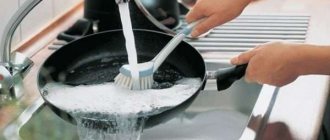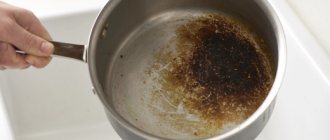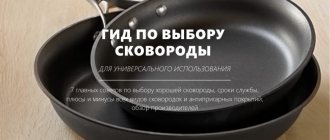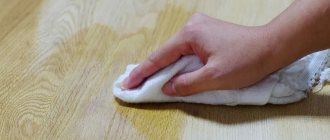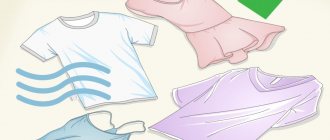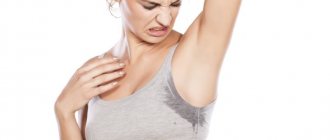A non-stick frying pan is a modern kitchen utensil that is found in almost every kitchen. Thanks to the coating, food does not stick to the inner surface of the cookware, and the food turns out more healthy. It is not necessary to use oil for frying in such pans, so dishes cooked on a non-stick coating can be safely classified as healthy food.
The disadvantage of protective coating is its fragility. The coating is easy to scratch and damage. The article will tell you whether non-stick cookware is dangerous, whether it is possible to use frying pans with a damaged inner layer, and how to restore a Teflon frying pan.
Are non-stick cookware dangerous?
The non-stick coating on the inside of the pan allows you to cook healthy food, but under certain conditions it can become dangerous.
Myths and facts
Don't rub them with the prickly sponges, and don't use too much force when you rub the bottom.
There is a myth that any non-stick coating is hazardous to health. However, in reality, only a scratched Teflon coating is dangerous, since it contains chemical elements. They penetrate into food if the surface coating layer is broken.
Important. The natural coating itself does not pose any threat, but scratches expose the metal from which the frying pan is made. When heated, metal releases harmful substances and gives food an unpleasant taste.
How to use a frying pan with a damaged non-stick coating
If it is not possible to urgently replace a damaged frying pan, it is recommended to use it as carefully as possible:
- stir food only with a wooden or silicone spatula;
- do not scrub dishes with a metal sponge;
- do not use abrasives for washing dishes;
- Do not wash the pan in the dishwasher;
- do not heat the dishes to temperatures exceeding 250°C;
- Do not use the pan for baking in the oven;
- Wipe dishes with sunflower oil once a week.
Non-stick material reacts poorly to high temperatures and aggressive alkaline components - it becomes drier and wears out faster.
Type 2 and 3. Cast iron and stainless steel
Stainless steel and cast iron are also popular materials for kitchen utensils. But they also need proper care. What should I do so that it doesn’t stick to the pan, and cooking with it is just a pleasure?
Protecting the surface of stainless steel and cast iron frying pans is quite simple:
- Cook only on a clean surface
. Is your aluminum pan burning? Perhaps the fact is that at the end of the last cooking you did not wash it well enough. Small stuck food particles can cause food to further stick to the surface.
- Do not use cold foods
. Before frying food, make sure it is at room temperature. For example, cold meat easily sticks to stainless steel dishes.
- Do not fry wet foods
. If water remains on the surface of the food, it will reduce the temperature of the hot oil, causing it to burn. Dry food with a paper towel before cooking. - Wait for the oil to heat up
. You can either add cold oil to a hot pan or start cooking by heating cold oil and a cold pan. - Don't use too many products
. Large amounts of food will release large amounts of liquid into the pan, lowering the temperature of the oil.
How to revive a burnt frying pan?
Cast iron frying pans are perhaps the most reliable and durable cookware. The porous thick material is able to retain heat for a long time, making it possible to slowly simmer dishes.
What should you do if, after unsuccessful cooking, everything starts to stick to your cast iron cookware? There are three very effective ways:
- Boil a frying pan with soda
. The main reason for poor performance of a frying pan is carbon deposits. To get rid of it, pour water into a frying pan and add a little baking soda. Boil for a few minutes. Wash. - Season the surface with salt
. Pour coarse salt into the frying pan (1 centimeter layer) and place it on the fire. Wait half an hour, turn off the heat and wait for the surface to cool. Then remove the salt with a napkin.
Flaxseed or sunflower oil will help enhance the effect of the procedure. Distribute it over the entire surface. The oil will create a thin film on the bottom of the pan, filling the small pores of the material.
- Fry the bread
. A very unexpected method, but one that solves the problem of how to restore the coating of a frying pan to which everything has begun to stick. Simply cut the bread into cubes and fry it over low heat without adding oil.
And finally, I’ll tell you one more proven trick. Try to cook in a cast iron frying pan as often as possible; this material requires regular attention. If the vessel has been collecting dust on the shelf for a long time, rinse it thoroughly and calcine it with salt, as described above.
Is it possible to repair damaged non-stick coating?
It is impossible to restore damaged non-stick coating on a frying pan at home. Creating the inner protective layer of cookware is a high-tech process that can only be carried out at the enterprise.
The non-stick layer is a mixture of different components, which is applied in liquid form to the surface of the frying pan. For example, stone spray is fine stone dust mixed with a binder. This coating is applied to cookware under high pressure. The pans are then dried in special chambers.
It is impossible to repeat these manipulations at home.
Often, a metal alloy is hidden under the non-stick layer, which is unsuitable for contact with food.
What is Teflon
Teflon is a polymer of tetrafluoroethylene (PTFE), a plastic that has unique properties and is widely used not only in the production of tableware, but also in equipment. Teflon is sprayed onto the inside of pans to create a non-stick effect.
Unique properties of Teflon:
- low coefficient of sliding friction;
- high thermal conductivity and frost resistance;
- does not attract water and fat molecules;
- chemical resistance is higher than that of gold and platinum;
- melting temperature from +260°C.
Restoring the Teflon coating on a frying pan is impossible. Damaged dishes are disposed of.
How harmful is it to human health?
Manufacturers of non-stick cookware assure that the products are safe if used carefully.
A Teflon-coated frying pan can be harmful in a number of cases:
- if you heat it above +230°C;
- if you scratch it.
Overheated Teflon releases harmful substances, transferring them to food. The same thing happens with scratched material. The polymer is not excreted from the body for a long time and causes serious harm to health.
Professional restoration will cost so much that it makes more sense to buy a new frying pan.
Choosing a frying pan that is safe for health
Let's look at the types of coatings and their effects on health.
Titanium
Titanium coating is a mixture of titanium dust with another substance. There are the following options for this spraying:
- titanium + teflon;
- titanium + ceramics;
- titanium + polymer.
The second type of protective layer, when metal dust is mixed with ceramics, is considered the safest. In this case, the frying pan receives an absolutely natural and safe coating. These pans are durable and lightweight.
Ceramics
Ceramics is an environmentally friendly coating that is also safe for human health. These pans are ideal not only for frying, but also for baking in the oven.
It is important to remember that ceramic protective coating is quite fragile. It can not only be scratched, but also broken.
Teflon
Fully synthetic coating, safe only if all operating conditions are strictly observed. Experts recommend buying such utensils on a limited budget or as temporary kitchen utensils, for travel or at the cottage.
Treatment
Many people are interested in what to do if a frying pan burns? To prevent this, special preparation is needed. Containers made of cast iron and aluminum are calcined before use. The following tips will also be helpful:
- For both materials, the processing option is the same - the container must be washed with warm water, dried, and put on low heat.
- Pour vegetable oil into the bottom of the dish and heat it for at least 40 minutes.
- Then the pan cools down, the oil must be drained, and the dishes must be wiped with paper napkins to remove fat.
- The container remains in this form for several days, and then it needs to be washed and can be used. As the metal heats up, it expands and oil penetrates into the pores. This serves as protection; the bottom of cast iron or aluminum becomes smooth. Food will not stick or burn.
The procedure should be repeated, since the protective film is destroyed with use. Heat the pan and add salt. You can't heat it up. The only solution to prevent the problem is to clean it with detergent, after which the container should be dried and rubbed with a piece of fat. This should be done before each cooking to prevent it from sticking.
Features of Teflon pans
What is Teflon? How harmful is the Teflon coating on a frying pan? What are the advantages of Teflon frying pans? How to properly use a new frying pan? How to clean and care for a non-stick Teflon frying pan?
These recommendations are the key to long and safe use of a Teflon-coated frying pan.
What is Teflon material?
Long gone are the days when weight was considered an indicator of the quality of cooking utensils. After all, it was in a heavy frying pan that food did not burn; it was convenient not only to bake, but also to stew vegetables and meat. Modern cooking utensils are lightweight and practical. With its help, you can cook even without oil, which makes homemade dishes not only tasty, but also healthy.
There are many types of non-stick coatings, but Teflon is considered the most popular and widespread. Let's look at the main features of this material.
Buy dishes with a thermopot (temperature indicator). This way you will save it from the danger of overheating.
Teflon is a very interesting material. It was created before the outbreak of the American World War II. Essentially, it is a gas that has polymerized to become polytetrafluoroethylene resin.
It was used in many fields of science and production, even prosthetic joints were made from it. Teflon gained its greatest popularity when they began producing frying pans with non-stick coatings. Here he took one of the first places.
With the most delicate handling, two to three years is the period after which the frying pan needs to be replaced.
What are the advantages and disadvantages of Teflon frying pans?
Any material combines positive and negative qualities. On the one hand, it is simply irreplaceable, but on the other, it requires special care or handling skills. This also applies to such a common material for non-stick coating of frying pans as Teflon.
Teflon frying pans have an important advantage - they are lighter in weight than ceramic ones and, of course, lighter than cast iron ones.
Let's look at them in more detail.
Advantages:
- Teflon-coated pans heat up quite quickly. This makes the cooking process more convenient and not very time-consuming.
- Teflon coating prevents the proliferation of pathogenic organisms.
- Cooking with them is also convenient because you don’t need to use a lot of oil. You just need to lightly grease the pan with a whisk, or you can do without it at all. Such food, moreover, becomes more healthy and low-calorie.
- Teflon-coated pans are easy to clean, because food does not stick and can be removed with a soft sponge without much effort.
- These dishes are light in weight. Lightness makes it more convenient to use.
- Teflon pans are quite durable, provided that the non-stick coating is not damaged.
This is the so-called light cookware, which means that you are supposed to cook quick dishes on it.
Flaws:
- The Teflon coating is quite fragile. If used or cleaned incorrectly, it can easily be damaged. For such a frying pan, it is better to use wooden, plastic or silicone utensils: spatulas, tongs, spoons.
- When using such pans, you should monitor the temperature. Failure to do so may result in damage to the coating.
- If the integrity of the Teflon coating is damaged at the slightest level, the frying pan becomes unusable.
The surface of the pans is sensitive and scratches easily.
Note! Teflon does not like too high temperatures (overheating occurs from too much heat or the presence of too thin bottom or side walls). If the pan gets too hot, the polymer begins to evaporate. And this is harmful to health.
What harmful properties does Teflon coating have for humans?
The Teflon non-stick coating is very smooth, even slippery. It allows you to make the cooking process simpler and more comfortable. However, it should be noted that in recent decades the question of its toxicity has increasingly begun to be raised.
The composition contains substances with toxic characteristics.
Despite the fact that Teflon has long been considered safe, laboratory studies have shown that this material can negatively affect human health. Let's consider what its danger is.
The “insidiousness” of Teflon is as follows: at temperatures up to 200 degrees it poses absolutely no threat, but after exceeding this temperature limit, this material begins to disintegrate into its components. And so they are carcinogens. The most dangerous of them are perfluoroisobutylene gas and perfluorooctanoic acid.
Thin pans become deformed when heated for long periods of time.
These substances affect the functioning of the thyroid and pancreas and disrupt the functioning of the immune system. They also contribute to cell mutation and the occurrence of cancer. Their negative impact causes the development of hormonal disorders.
The release of dangerous components of Teflon occurs when using cookware with a damaged non-stick coating, even at temperatures up to 200 degrees.
How to properly use a new Teflon frying pan
In order for a new Teflon-coated frying pan to serve as long as possible and perform its functions well, it is necessary to carry out a special procedure before first use. Wash it well, removing everything unnecessary (without using abrasives or metal scrapers or sponges), dry it and keep it on low heat for half a minute. After this, it is advisable to lightly grease the pan with sunflower or other vegetable oil.
They are easy to clean, but some owners, out of habit, use abrasives, which quickly damages the dishes.
These simple steps will prepare the non-stick coating for further cooking processes and protect it from damage.
Which coating is better, Teflon or ceramic?
Ceramic, along with Teflon, is one of the most popular non-stick coatings. To figure out which one is better, let's look at the pros and cons of the first.
Advantages of ceramic coating:
- Withstands very high temperatures - about 450 degrees.
- More resistant to mechanical damage than Teflon.
- During the cooking process, you can use a small amount of oil (only the necessary minimum).
- Easy to clean.
- Does not release carcinogenic substances when heated.
The size of the bottom layer affects the strength of the pan when heated.
The thicker the bottom, the lower the risk of deformation of the pan. Disadvantages of ceramic coating:
- Afraid of too strong temperature changes (a hot frying pan under cold water).
- You cannot use metal utensils, only wood, plastic, and silicone.
- You should not soak such products for a long time. It's better to wash immediately.
The lightest models, as a rule, are not durable and strong, and deformation of the coating can be relatively rapid.
Based on the characteristics of the ceramic coating, we can conclude that it is an environmentally friendly alternative to Teflon, while having all its positive characteristics.
Recommendations for choosing a quality cast iron frying pan with Teflon coating
A cast iron non-stick frying pan is a very important piece of cookware. It is assigned a number of functions, and therefore, when buying it, every housewife wants to receive a practical and convenient product as a result. To prevent your purchase from becoming a disappointment, you need to pay attention to important recommendations.
- The bottom of such a frying pan should be as thick as possible. The same applies to the walls.
- To control the heating level, it is recommended to buy frying pans with a special indicator. It is located at the bottom inside and changes color depending on the temperature.
- It is best to choose frying pans with a very textured bottom. In this case, the more convexity, the better.
- If the bottom is smooth, without relief, then it should be perfectly flat. Pits or bumps indicate defects for which such a product cannot be used.
- When choosing an external coating, it is recommended to give preference to enamel. It is more resistant to mechanical damage (including when trying to clean). Varnish quickly scratches and burns.
- The size of the bottom must correspond to the diameter of the burners. If it is less, the food near the side walls will burn; if it is more, it will remain uncooked.
- The handle is more comfortable and will last longer if it is cast, that is, it is a single whole with the entire frying pan. The material for it should be with low thermal conductivity. This will protect you from burns.
- Before purchasing a cast iron frying pan, you should inspect it carefully. It may be damaged during transportation.
- You should not buy Teflon frying pans in stores without a special license for the product and a certificate of conformity. Such products may be counterfeit and cause harm to health.
A solid surface layer guarantees uniform heating and, no less important, the quality of the prepared dish.
How to clean a Teflon frying pan from carbon deposits at home
Despite the non-stick Teflon coating, over time such pans are still susceptible to the formation of soot. Its presence not only interferes with cooking, but can also release harmful substances into food. Therefore, the question arises: how to clean a Teflon cast-iron frying pan from the deposits that have formed?
For cleaning, various products are used, both chemical and organic.
The complexity of the process of removing it is explained by the fact that when cleaning the non-stick coating, you cannot use abrasive agents or devices that can scratch it. Therefore, only gentle cleaners should be used for this procedure. Let's look at the most effective of them.
Inside
As a rule, to clean the internal surfaces of dishes, they use products that are not toxic or carcinogenic, because they will penetrate, albeit partially, into the food being prepared. The most gentle and safest are:
- Laundry soap.
Recipe: Grate a quarter of the block, put it in a frying pan, add water. Bring the mixture to a boil, but do not let it boil. Leave for 2-3 hours. Afterwards, you need to drain the solution and wash the surface with regular dish soap. Remove residues with a sponge. Rinse.
To remove complex contaminants, manipulations must be carried out several times to completely get rid of traces of soot.
- Soda.
Recipe: Mix 5 teaspoons of baking soda with 1 liter of water. Pour into a frying pan and boil for 20 minutes. Drain. Rinse with clean water, if necessary, with detergent.
It is safer and more practical to wash the pan by hand.
- Baking soda and dish detergent.
Recipe: Dissolve 1 tablespoon of baking soda in 1 liter of water, add a couple of drops of detergent. Pour it into the frying pan. After boiling, remove from heat and let cool for 40-50 minutes. Rinse.
Boil the frying pan for a couple of minutes with plain clean water without additives.
- Soda and office glue.
Recipe: Mix 1 bottle of office glue with a third of a pack of soda. Pour into a pan half filled with water. Boil for 40-45 minutes. Leave from heat for 2-3 hours. If the soot is very strong, then the settling time can be increased to 24 hours. Wash well with detergent.
Never wash Teflon utensils with abrasive substances.
Outside
Keeping the outside of the pan clean is just as important as the inside. If there is a thick layer of soot, its heating will be uneven, and burnout will contribute to the formation of smoke. When removing carbon deposits from the outside of a Teflon frying pan, you must ensure that detergents do not get inside during cleaning. Since household chemicals can affect the quality of prepared food.
For such purposes, concentrated or spray gels and liquids are most often used. They are left for 15-30 minutes, after which they are removed with a sponge and rinsed.
If the use of cleaning chemicals is undesirable, then more conservative agents can be used. Here are some of them.
- Laundry soap and baking soda.
Recipe: Grate 2.5 pieces of soap and melt them together with 2.5 packs of soda in water. It is best to do this in a bucket or deep pan. Boil the frying pan in this solution for 2 hours. Wash with water and detergent. Rinse.
Don't rub them with the prickly sponges, and don't use too much force when you rub the bottom.
- Soda, detergent, office glue.
Make a solution of 3 liters of water, 150 grams of dishwashing liquid, 200 grams of soda, 50 grams of office glue. Soak the pan in it for 24 hours without boiling. Rinse off with hot water.
Non-stick material reacts poorly to high temperatures and aggressive alkaline components - it becomes drier and wears out faster.
How to remove Teflon from a frying pan
If the Teflon coating has been damaged, some users attempt to remove it using abrasive materials, such as sandpaper or sandblasting. However, it should be remembered that such a frying pan becomes unusable. Once all Teflon residues have been removed, it cannot be used for cooking. Even if there are no residual harmful substances in such a frying pan, it is almost impossible to fry, since during the removal of Teflon the top layer of cast iron is severely damaged, which leads to burning. Therefore, to the question “How to remove damaged Teflon coating from a frying pan?” there is an answer to the question “Is it worth it?”
Often, a metal alloy is hidden under the non-stick layer, which is unsuitable for contact with food.
Is it possible to restore Teflon coating?
Damaged non-stick coating can only be restored in special service centers. However, when applying new layers of Teflon, various types of defects may appear, which will shorten the service life of such a product, and such “reanimation” will be expensive and such workshops are not located in every city. It’s easier to buy a new frying pan and be sure of its safety.
Professional restoration will cost so much that it makes more sense to buy a new frying pan.
Caring for a Teflon frying pan
Teflon, like any other non-stick coating, requires special care. To keep it intact, you should follow a number of recommendations.
Rules for using a Teflon-coated frying pan:
- Detergents should not contain scratching components (granules, microparticles).
- Alkaline cleaners should not be used.
- This frying pan can only be washed with soft cloths or sponges.
- When preparing a dish, it is prohibited to use metal utensils: forks, spoons, spatulas. Only wooden or made of special plastic.
- A sudden change in temperature is strictly prohibited: a hot frying pan should not be placed under running cold water.
- You can cook on a non-stick coating without oil, but this will shorten its service life. It’s better to lightly grease the bottom of the pan with a whisk dipped in oil.
- After cooking, the food should be transferred to another container. The frying pan itself must be thoroughly washed and lightly greased with oil.
These recommendations are the key to long and safe use of a Teflon-coated frying pan.
How long do Teflon pans last?
The service life of a Teflon frying pan depends on its thickness.
- 3-4 years – with a thin bottom and side walls.
- 5-6 years - with a cellular (not smooth) coating and a fairly thick bottom.
- About 10 years old - with a thick bottom, side walls and multi-step Teflon coating (it has a rough texture).
With the most delicate handling, two to three years is the period after which the frying pan needs to be replaced.
Popular manufacturers of Teflon frying pans
The most famous companies engaged in the production of such tableware delight us with their new products and improved models from year to year. The leading ones among them are the following.
- Tefal.
- Rondell.
- Fissler.
- NMP (Neva-Metal Utensils).
- Gipfel.
- Vitesse.
Teflon coating is a convenient invention designed to facilitate the cooking process. However, we should not forget that everything has two sides: positive and negative. When choosing a frying pan with such a non-stick coating, be very careful and careful. And may your kitchen be safe.
Buy dishes with a thermopot (temperature indicator). This way you will save it from the danger of overheating.
VIDEO: How to check the Teflon coating of a frying pan.
Additional cleaning
Of course, salt alone will not be enough in this case.
Immediately after you have heated a dirty pan for an hour, pour out all the used salt from it, rinse the surface of the pan with tap water and wipe dry.
The next auxiliary substance for cleaning will be regular vegetable oil.
You need to pour a lot of it, and it is better to pour it immediately into a heated utensil.
In this case, too much fire here will be more harmful than useful: then you will have to clean the entire kitchen from scattered splashes of boiling oil within a radius of 2 meters.
Leave the pan to heat over low heat for 40 minutes.
When all the oil has completely boiled, you just need to pour it out and let the pan cool. It is not recommended to immediately pour water into it to avoid splashes and hot steam. To complete the difficult cleansing process, you just need to boil water in a frying pan several times
The more procedures you perform, the cleaner the walls will be. After finishing work, cool the pan and simply wipe with a dry towel.
